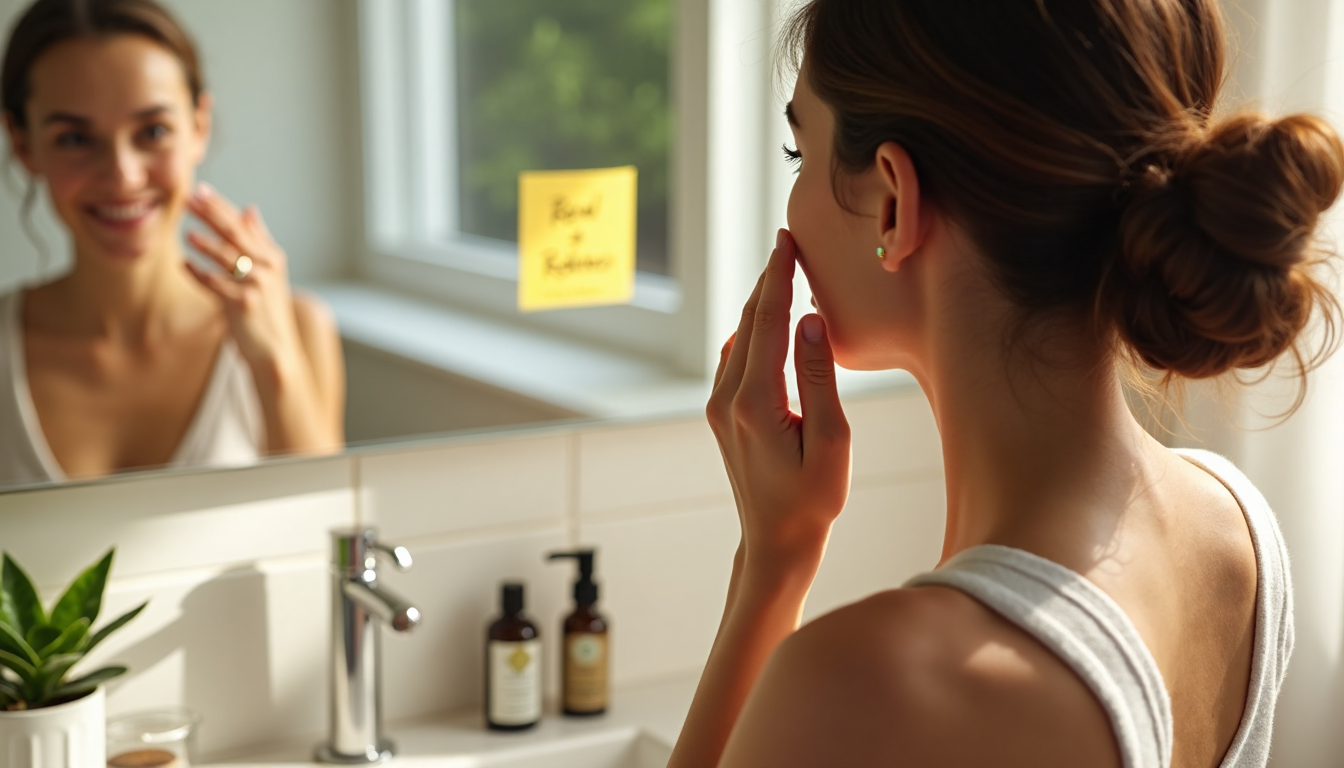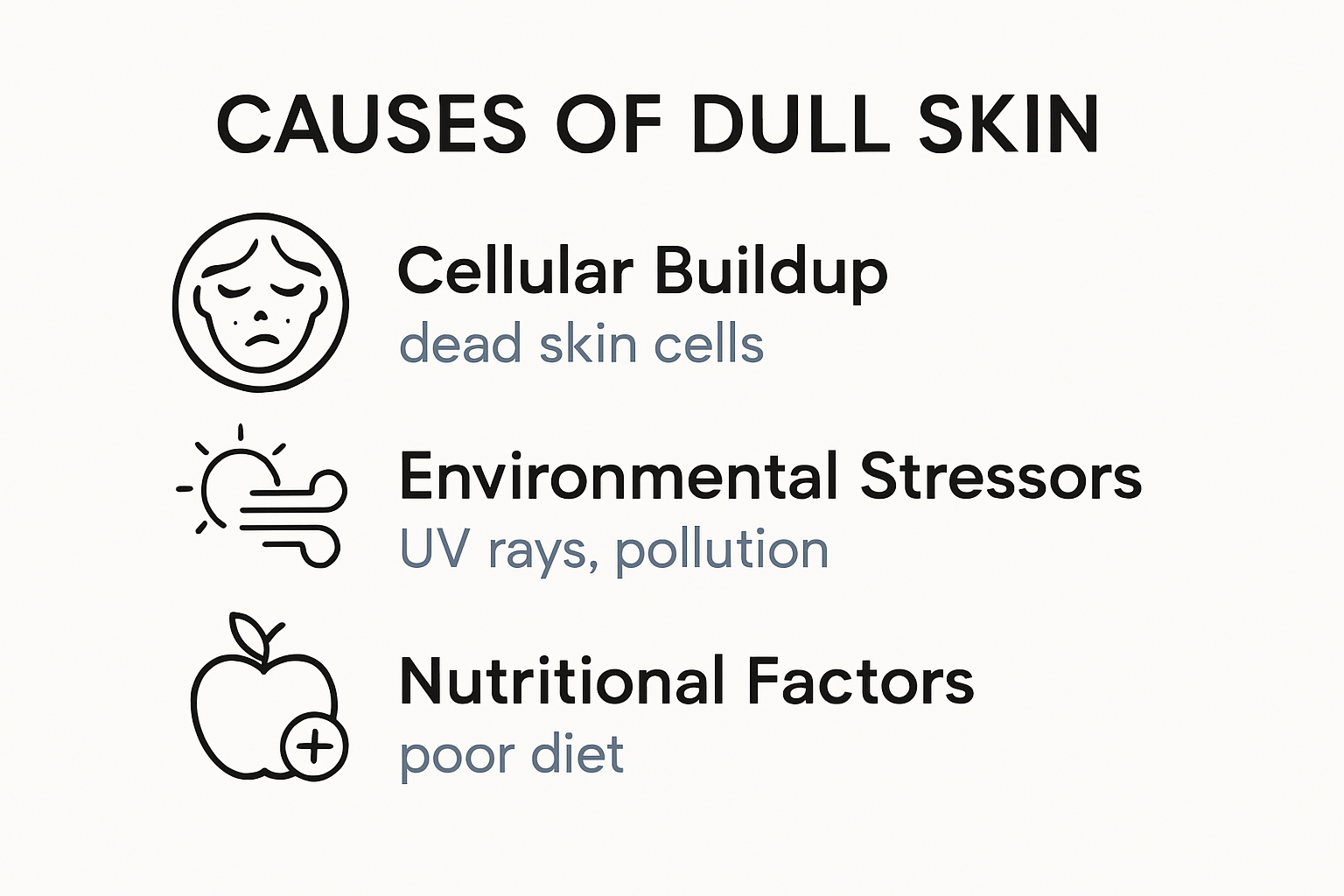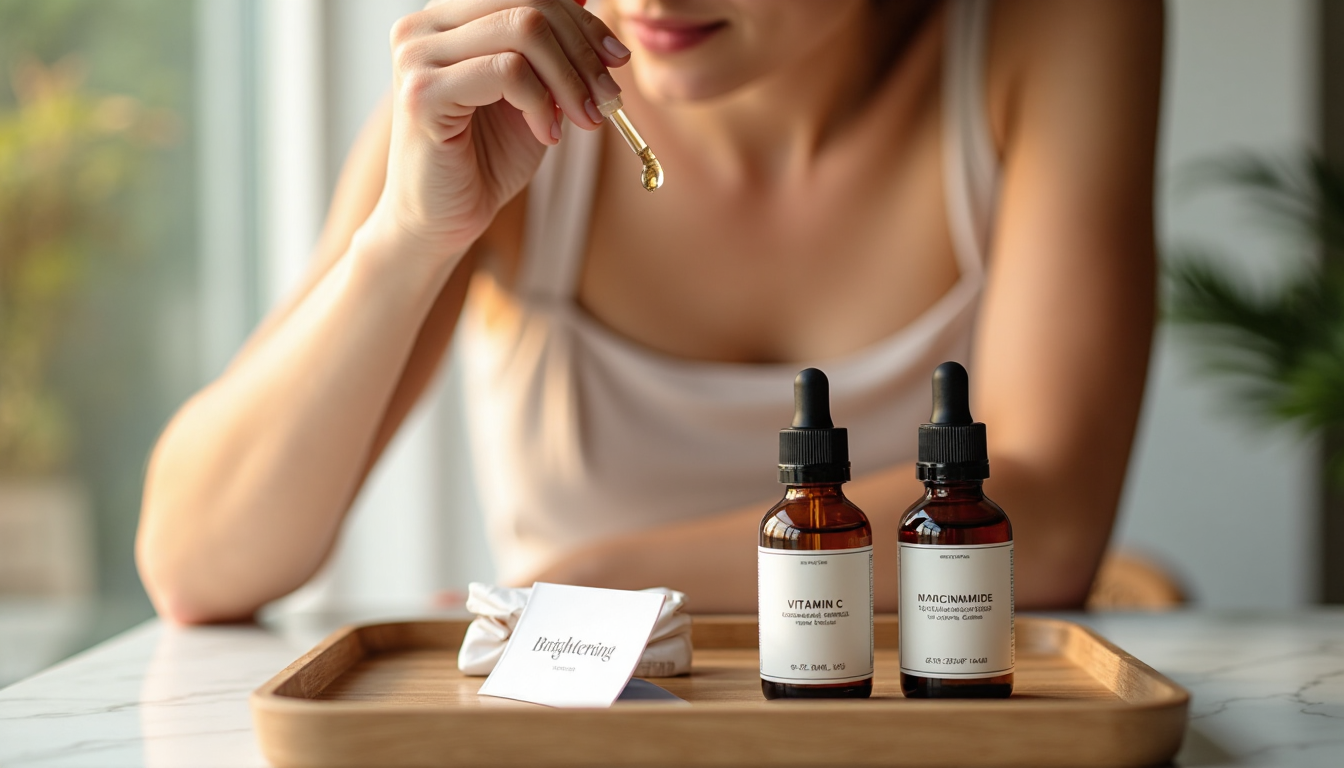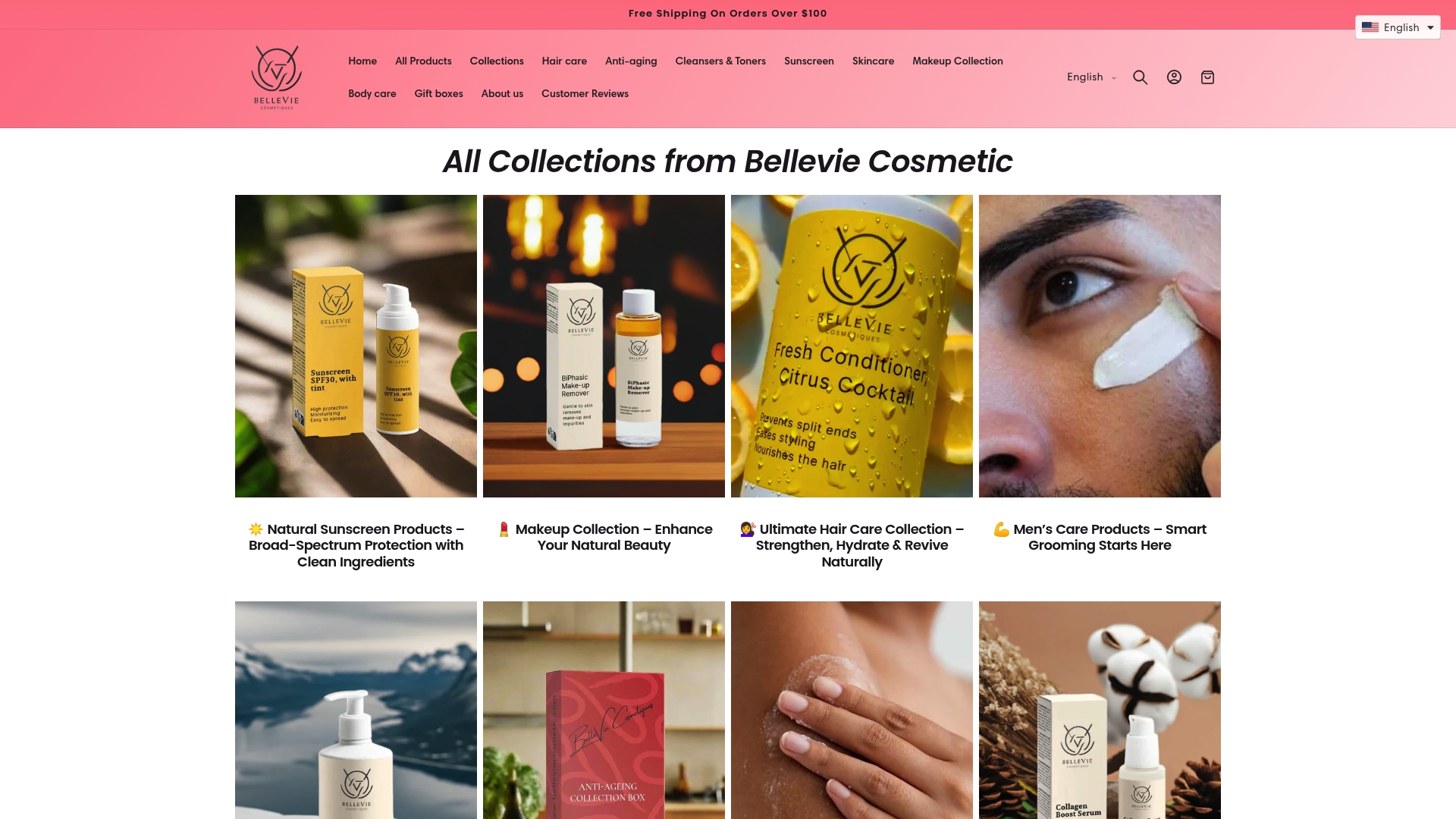
Dull skin is more than just a fleeting beauty issue. Nearly 40,000 dead skin cells shed every hour, yet that natural renewal process slows over time and creates a tired, lackluster look. But here’s the surprise. The secret to radiant skin is not just about what you put on your face, it also comes from your diet, daily routine, and even how you handle stress. That means the real glow-up starts from the inside out, and the latest expert-backed strategies for 2025 might just flip your skincare approach upside down.
Table of Contents
- Understanding The Causes Of Dull Skin
- Effective Skincare Ingredients For Brightening
- Daily Routines For Glowing, Youthful Skin
- Zero Waste And Eco-Friendly Beauty Solutions
Quick Summary
| Takeaway | Explanation |
|---|---|
| Address cellular buildup | Regular exfoliation is essential to prevent the accumulation of dead skin cells that leads to dullness and encourages healthy skin renewal. |
| Incorporate antioxidant-rich ingredients | Utilizing products with Vitamin C, Niacinamide, and Green Tea Extract can protect skin from oxidative stress and enhance brightness. |
| Establish consistent skincare routines | Daily practices, such as morning cleansing, antioxidant application, and evening repair strategies, are crucial for maintaining radiant skin health. |
| Emphasize hydration and nutrition | Adequate hydration and a balanced diet rich in antioxidants and omega-3s are vital for promoting skin luminosity from within. |
| Adopt sustainable beauty practices | Engaging in zero waste and eco-friendly beauty solutions can complement personal wellness with environmental health, creating a holistic approach to skincare. |
Understanding the Causes of Dull Skin
Skin health is a complex interplay of internal and external factors that directly impact its appearance and radiance. Dull skin represents more than just a cosmetic concern—it signals underlying physiological processes that require attention and strategic intervention.

To clarify the primary contributors to dull skin, the following table summarizes the main causes and the specific examples highlighted in this section.
| Main Cause | Specific Examples |
|---|---|
| Cellular Buildup | Hormonal changes, insufficient exfoliation, aging processes |
| Environmental & Lifestyle | Pollution exposure, inadequate hydration, chronic stress, poor sleep patterns |
| Nutritional & Metabolic | Insufficient water intake, vitamin deficiencies (A, C, E), compromised gut health, hormonal imbalances |
Cellular Buildup and Skin Renewal Challenges
The human skin constantly undergoes a natural renewal process, shedding approximately 30,000 to 40,000 dead skin cells every hour. However, when this process becomes disrupted, dead skin cells accumulate, creating a lackluster appearance. Research from the American Academy of Dermatology reveals that cell turnover naturally slows with age, making proactive skin maintenance crucial.
Factors contributing to cellular buildup include:
- Hormonal changes affecting skin cell regeneration
- Insufficient exfoliation preventing natural skin renewal
- Aging processes that reduce cellular metabolism
Environmental and Lifestyle Stressors
External elements play a significant role in skin dullness. Environmental Health Perspectives highlights how environmental pollutants and UV exposure can dramatically impact skin cellular health. Air pollution, for instance, generates free radicals that accelerate skin damage and reduce natural luminosity.
Key environmental and lifestyle contributors include:
- Pollution exposure creating oxidative stress
- Inadequate hydration reducing skin elasticity
- Chronic stress disrupting skin’s natural regeneration processes
- Poor sleep patterns preventing optimal cellular repair
Nutritional and Metabolic Influences
Nutrition plays a fundamental role in skin appearance. The Journal of Clinical and Aesthetic Dermatology emphasizes that micronutrient deficiencies can directly manifest as dull, uneven skin tone. Specific nutritional gaps can impair skin’s natural radiance and cellular function.
Metabolic factors affecting skin luminosity encompass:
- Insufficient water intake reducing cellular hydration
- Vitamin deficiencies particularly vitamins A, C, and E
- Compromised gut health impacting nutrient absorption
- Hormonal imbalances disrupting skin’s natural regeneration
Understanding these multifaceted causes provides a comprehensive approach to rejuvenating dull skin. By addressing cellular, environmental, and nutritional factors holistically, individuals can restore their skin’s natural luminosity and health.
Effective Skincare Ingredients for Brightening

Achieving a luminous complexion requires strategic selection of potent skincare ingredients that target skin dullness at its cellular level. The right combination of active compounds can transform lackluster skin into a radiant canvas of healthy luminosity.
Here’s a table summarizing the top skincare ingredient categories and their key benefits for brightening and revitalizing skin, as discussed in this section.
| Ingredient Category | Example Ingredients | Main Benefits |
|---|---|---|
| Powerful Antioxidant Brighteners | Vitamin C, Niacinamide, Green Tea Extract | Neutralize free radicals, brighten skin, strengthen barrier |
| Cellular Renewal & Pigmentation | Alpha Arbutin, Kojic Acid, Galactomyces Ferment Filtrate, Peptides | Increase cell turnover, lighten dark spots, improve pigmentation |
| Hydration & Barrier Support | Hyaluronic Acid, Ceramides, Panthenol | Deep hydration, strengthen skin barrier, support healing |
Powerful Antioxidant Brighteners
Research from the Journal of Cosmetic Dermatology reveals that certain ingredients possess extraordinary skin-brightening capabilities. Vitamin C stands out as a premier antioxidant, working to neutralize free radicals while promoting collagen synthesis and reducing hyperpigmentation.
Key antioxidant ingredients include:
- Vitamin C dramatically reduces dark spots and enhances overall skin brightness
- Niacinamide regulates melanin production and strengthens skin barrier function
- Green Tea Extract provides powerful protective antioxidants that combat environmental damage
Cellular Renewal and Pigmentation Regulators
Dermatology Research demonstrates that certain ingredients can dramatically improve skin cell turnover and pigmentation control. Kojic Acid emerges as a significant compound that inhibits melanin production, effectively addressing uneven skin tone.
Advanced cellular renewal ingredients encompass:
- Alpha Arbutin provides gentle yet effective skin lightening
- Galactomyces Ferment Filtrate balances skin tone and provides deep hydration
- Peptides stimulate collagen production and enhance skin regeneration
Hydration and Barrier Support Ingredients
Clinical studies in Cosmetic Dermatology emphasize that proper hydration is crucial for maintaining skin brightness. Ingredients that support moisture retention and strengthen the skin barrier play a critical role in achieving a radiant complexion.
Hydration and barrier support ingredients include:
- Hyaluronic Acid attracts and retains moisture at cellular levels
- Ceramides restore and protect the skin’s natural protective barrier
- Panthenol provides deep hydration and supports skin healing
Selecting the right combination of these ingredients can transform dull skin into a luminous, healthy complexion. Understanding each ingredient’s unique properties allows for a targeted approach to skin rejuvenation, addressing multiple aspects of skin health simultaneously.
Daily Routines for Glowing, Youthful Skin
Creating a consistent skincare routine is fundamental to maintaining radiant, healthy skin. Beyond sporadic treatments, daily practices can significantly transform skin appearance and long-term health.
Morning Skincare Ritual
The American Academy of Dermatology recommends a strategic morning routine that prepares and protects skin for daily environmental challenges. Starting with gentle cleansing removes overnight accumulation of oils and cellular debris, creating a clean canvas for subsequent skincare steps.
Key morning routine components include:
- Gentle Cleansing using a pH-balanced cleanser
- Antioxidant Serum to protect against free radical damage
- Hydrating Moisturizer to maintain skin barrier function
- Broad-Spectrum Sunscreen with minimum SPF 30 to prevent UV damage
Evening Skin Renewal Strategy
Dermatology Research emphasizes the importance of nighttime skin repair processes. Evening routines should focus on cellular regeneration, hydration, and targeted treatment of specific skin concerns.
Essential evening skincare steps involve:
- Double Cleansing to thoroughly remove makeup and environmental pollutants
- Exfoliation 2-3 times weekly to promote cell turnover
- Repair Serums containing active ingredients like retinol or peptides
- Intensive Moisturizer to support overnight skin recovery
Holistic Skin Health Approach
The National Institutes of Health underscores that skin health extends beyond topical treatments. A comprehensive approach integrates nutrition, hydration, stress management, and lifestyle factors.
Holistic skin wellness strategies include:
- Balanced Nutrition rich in antioxidants and omega-3 fatty acids
- Adequate Hydration consuming minimum 8 glasses of water daily
- Regular Exercise to improve circulation and skin oxygenation
- Stress Management through meditation or relaxation techniques
Consistent implementation of these routines transforms skin from merely functional to radiantly healthy. By understanding and responding to your skin’s unique needs, you create a personalized pathway to lasting skin vitality and youthful luminosity.
Zero Waste and Eco-Friendly Beauty Solutions
The beauty industry is undergoing a transformative shift towards sustainability, recognizing the critical importance of environmentally conscious practices in skincare and personal care. Zero waste beauty solutions represent a holistic approach to skin health that prioritizes both personal wellness and planetary well-being.
Sustainable Ingredient Innovation
Research in Bioengineering reveals groundbreaking approaches to sustainable skincare. Innovative scientists are now repurposing food by-products to create powerful skincare ingredients, dramatically reducing waste while enhancing product efficacy.
Cutting-edge sustainable ingredient strategies include:
- Citrus Peel Extracts transformed into advanced nanocarriers
- Almond By-products rich in antioxidants and skin-nurturing compounds
- Tea Polyphenols offering natural preservation and skin-protective properties
- Upcycled Botanical Ingredients minimizing agricultural waste
Eco-Friendly Packaging and Consumption
The Journal of Cleaner Production highlights the critical role of packaging in sustainable beauty. Consumers are increasingly demanding packaging solutions that minimize environmental impact while maintaining product integrity.
Eco-conscious packaging innovations feature:
- Biodegradable Packaging Materials
- Refillable Container Systems
- Plastic-Free Packaging Options
- Carbon-Neutral Production Processes
Holistic Sustainable Beauty Practices
Environmental Health Perspectives emphasizes that true sustainability extends beyond product formulation. A comprehensive approach considers the entire lifecycle of beauty products, from ingredient sourcing to final disposal.
Holistic sustainable beauty principles encompass:
- Minimalist Skincare Routines reducing overall product consumption
- Ethical Ingredient Sourcing
- Support for Circular Economy Initiatives
- Conscious Consumer Education
Zero waste beauty is more than a trend—it represents a fundamental reimagining of personal care. By embracing sustainable practices, individuals can achieve radiant skin while contributing to environmental preservation. The future of skincare lies in solutions that nourish both personal health and planetary well-being, creating a harmonious approach to beauty that extends far beyond surface-level considerations.
Frequently Asked Questions
What causes dull skin?
Dull skin can be caused by factors such as cellular buildup from aging, environmental stressors like pollution and UV exposure, and nutritional deficiencies, particularly in vitamins and hydration.
How can I brighten my dull skin?
To brighten dull skin, use effective skincare ingredients like Vitamin C, Niacinamide, and exfoliants such as Alpha Arbutin and Kojic Acid, while establishing a consistent morning and evening skincare routine.
What daily routine should I follow for glowing skin?
For glowing skin, a morning routine should include gentle cleansing, antioxidant application, moisturizer, and sunscreen. In the evening, focus on double cleansing, exfoliation, repair serums, and hydration to support skin renewal.
Are there eco-friendly options for skincare?
Yes, eco-friendly skincare options include using sustainable ingredients, opting for biodegradable or refillable packaging, and following minimalist routines that minimize waste, contributing to both personal wellness and environmental health.
Reclaim Your Radiance With Pure, Proven Ingredients
If you are frustrated by persistent dull skin, uneven tone, or a lack of natural glow, you are not alone. The article above highlights how cellular buildup, environmental stress, and hydration gaps often leave your complexion tired and lackluster. You deserve solutions that work with your skin—not against it—using clean brightening actives and deep hydration that truly make a difference.

Now it is your turn to experience the results of expert-backed skincare. Explore the collection of natural and clinically proven formulas at BelleVie. Each product is crafted for real transformation using Vitamin C, niacinamide, and nutrient-dense botanical extracts, just like those recommended in the article. Shop now for your healthiest glow yet, enjoy free shipping on orders over $100, and unlock an exclusive $25 skincare gift when you subscribe and spend $60. Your journey to luminous, rejuvenated skin begins here.

